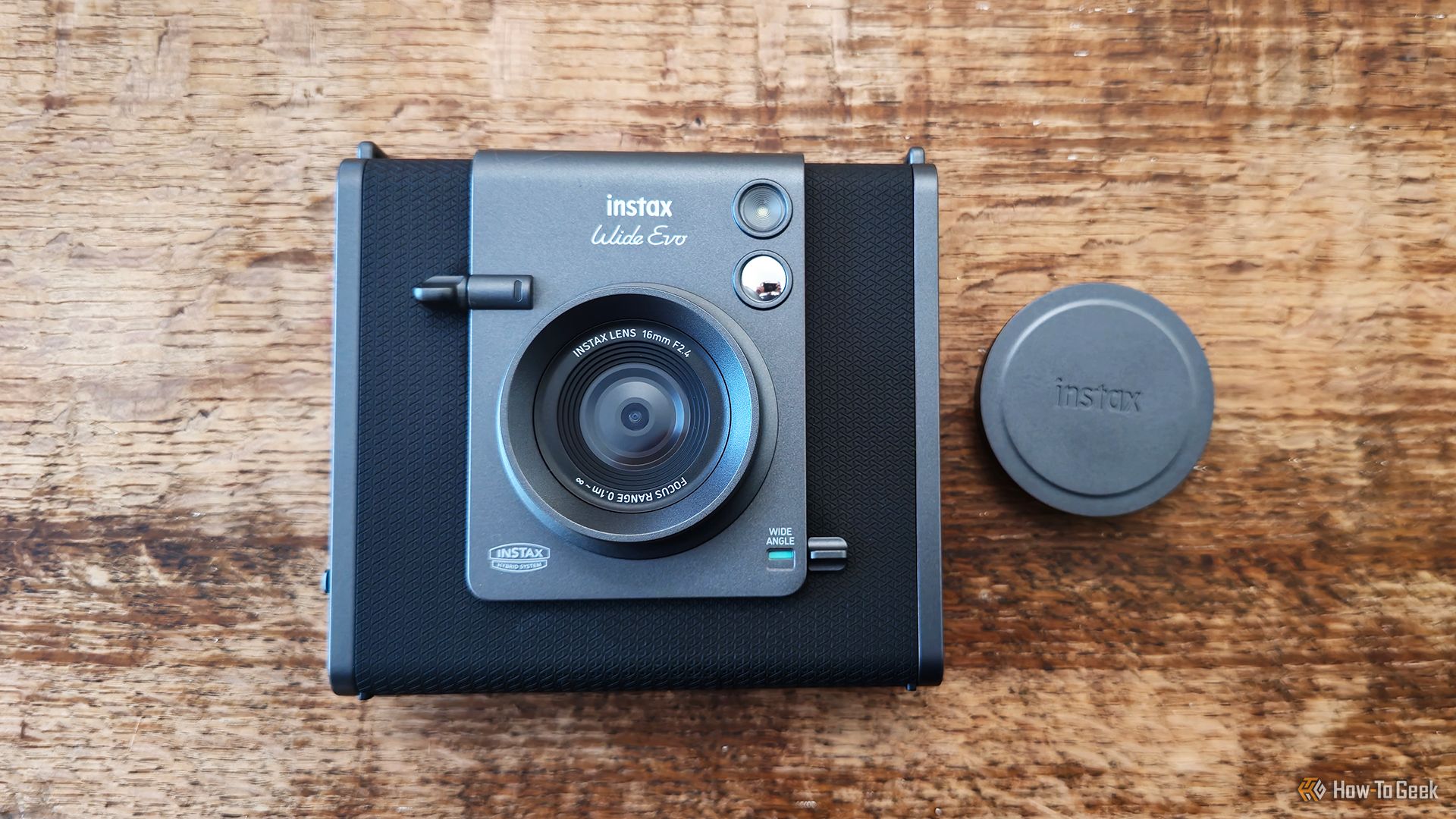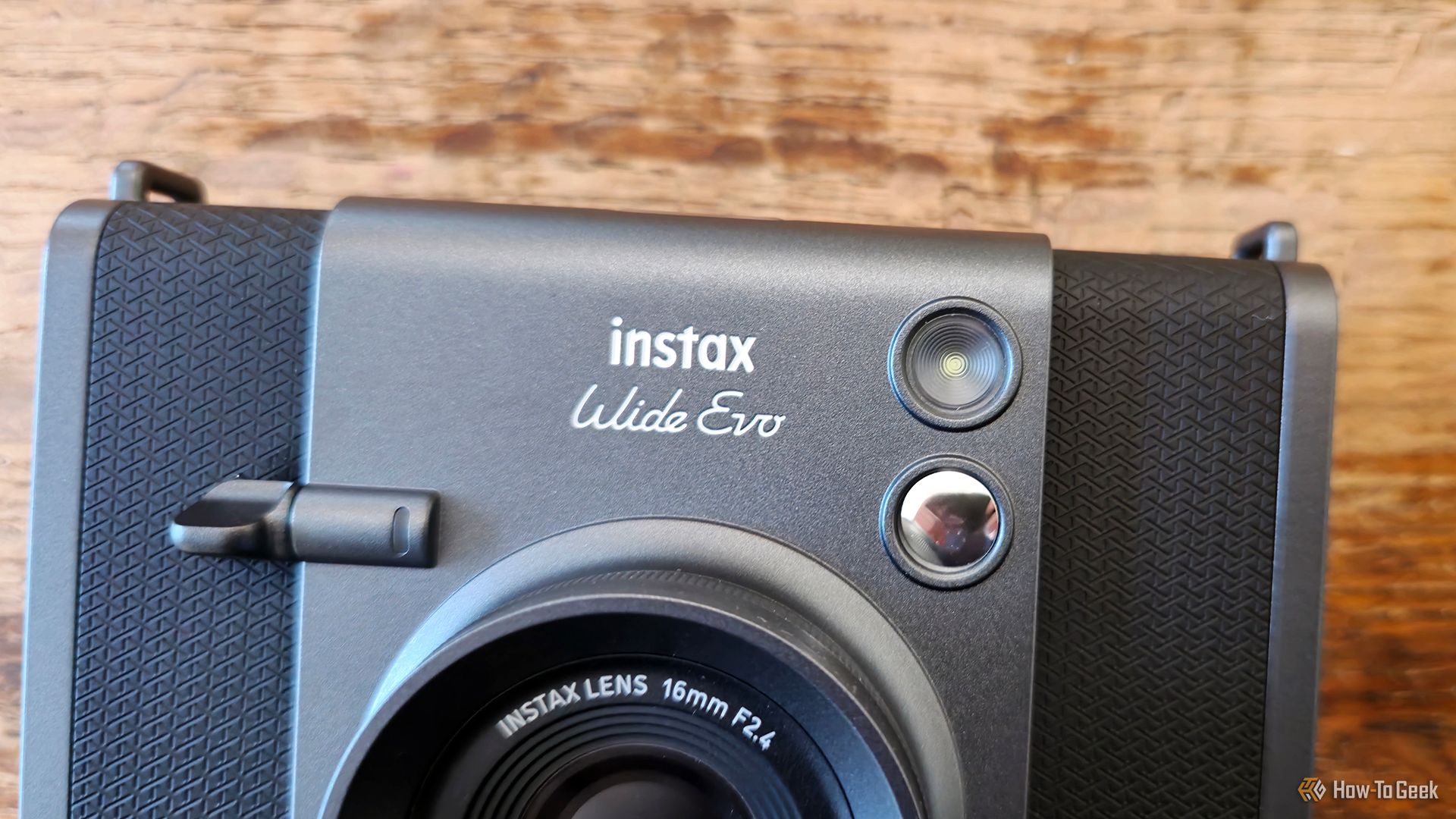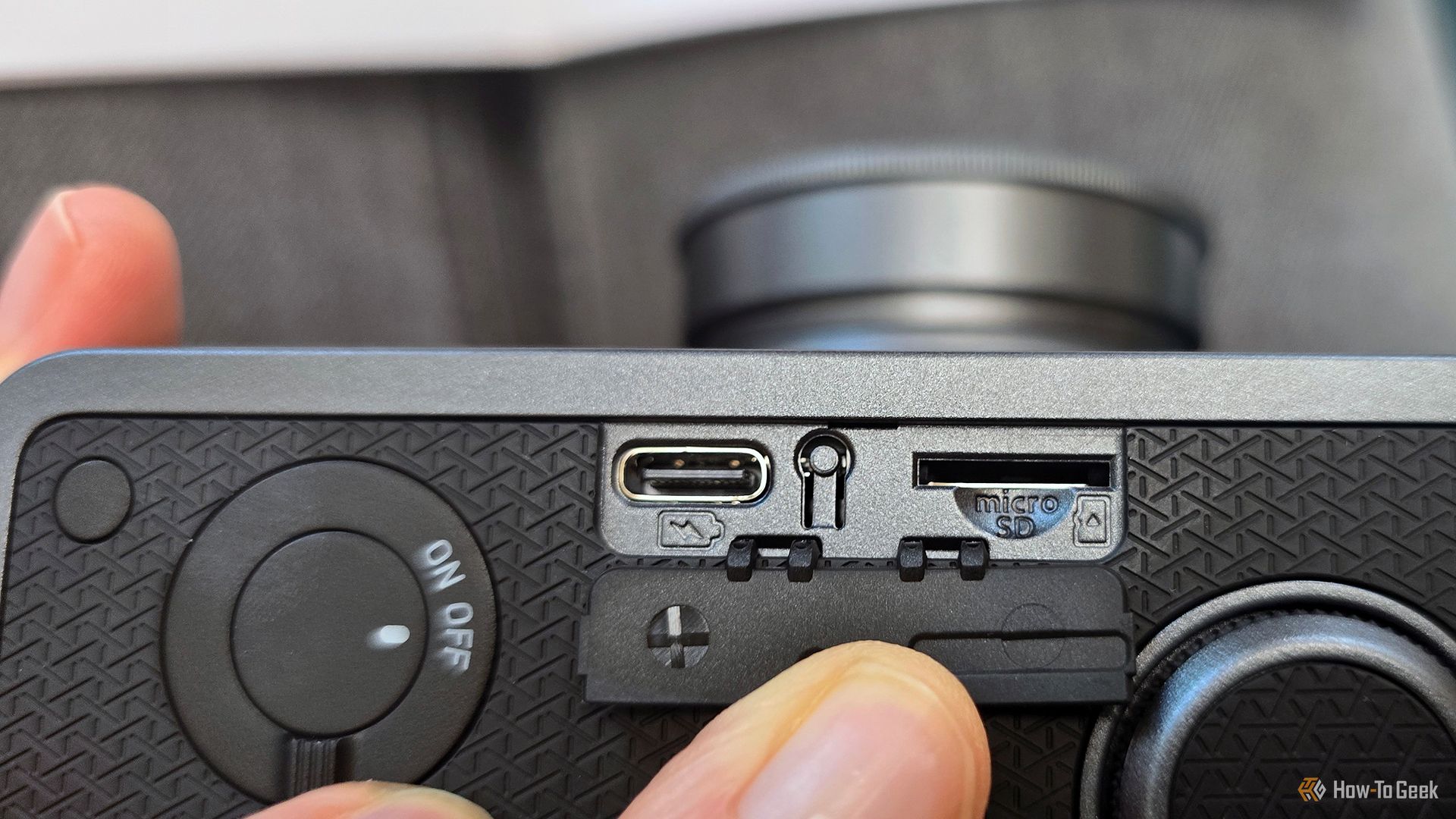Summary
- The Instax WIDE Evo has a fun, retro design with modern tech for easy photo customization and printing.
- Its easy-to-navigate UI makes it a breeze to take photos, edit them, and print them.
- Impressive wide-angle photos make it stand out, but its shutter lag and short battery life are its weaknesses.
Fujifilm upgraded its past Evo with the Instax WIDE Evo‘s wide-angle photography. While it lacks pro-level photo quality, its other features–including plenty of customization options, a retro-style design, and smartphone photo printing–made me fall in love with taking photos again.
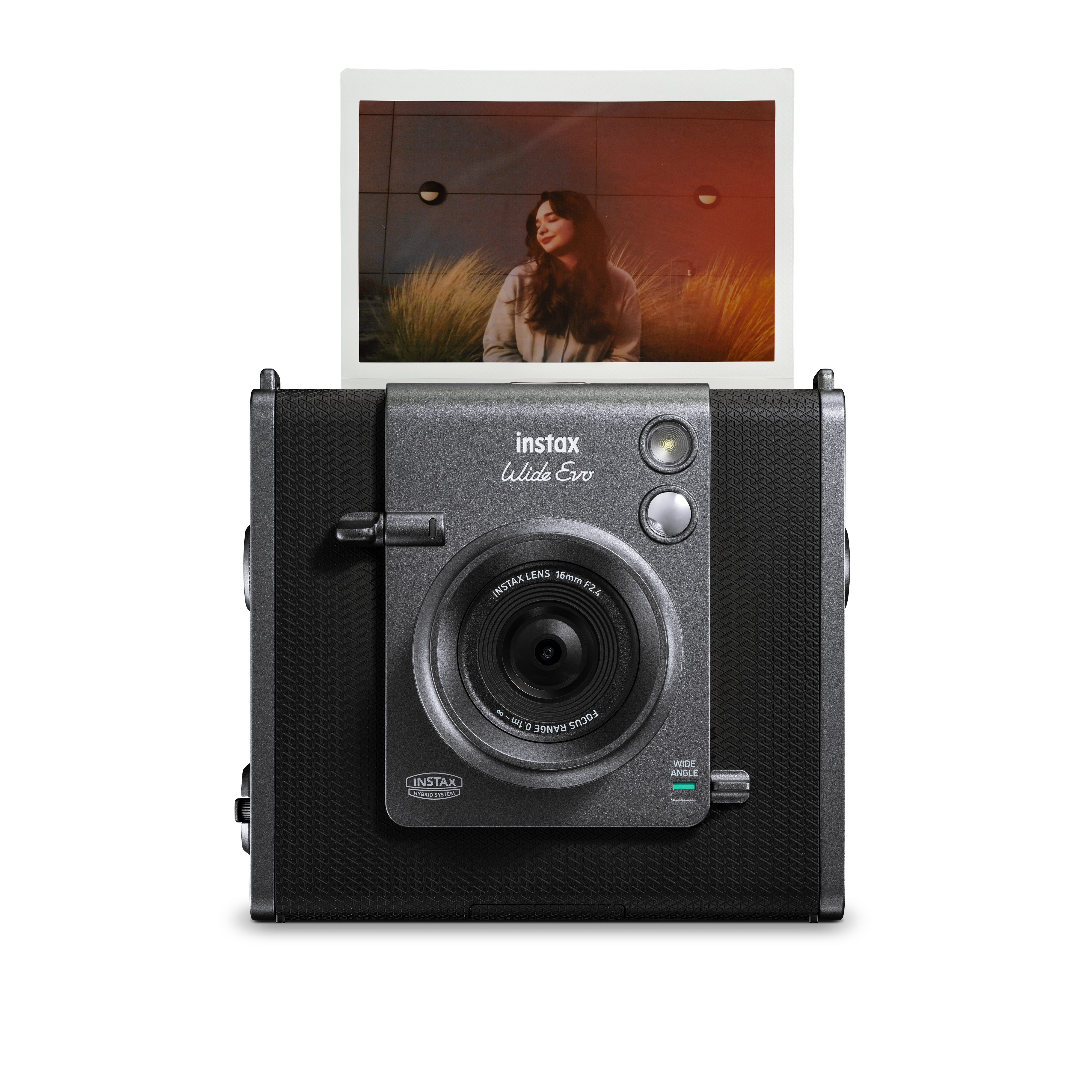

Fujifilm Instax Wide Evo
Packed with plenty of photo effects and an easy-to-navigate UI, the Fujifilm Instax WIDE Evo is a fun, retro-style camera for the amateur photographer who wants the instant gratification of printing photos straight from the device.
- Fun retro-style design with convenient modern tech
- Plenty of customization options for photos
- Easy-to-navigate UI
- Great wide photos
- Convenient smartphone printing
- Poor battery life
- Slow shutter speed
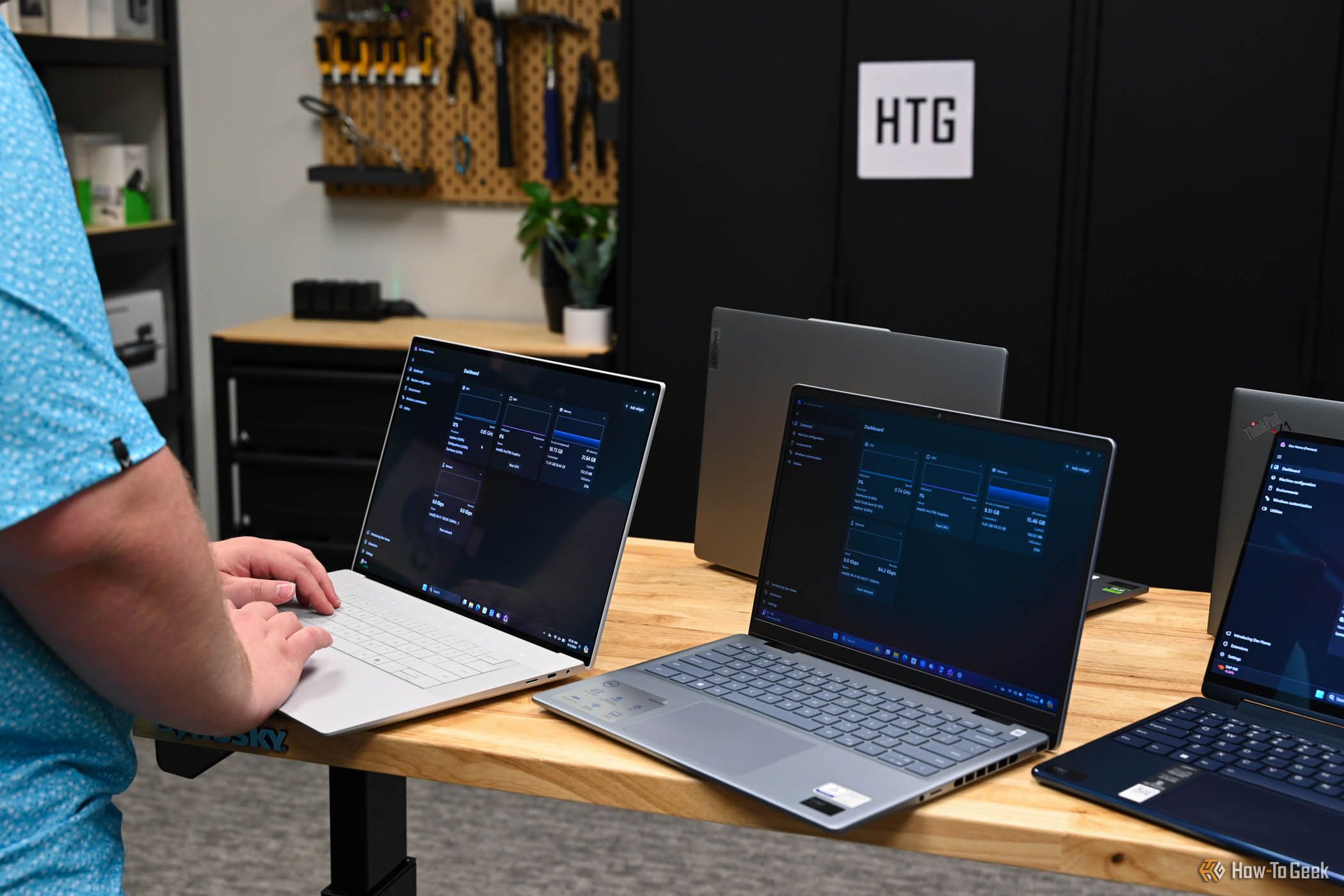
See Our Process
How We Test and Review Products at How-To Geek
We go hands-on with every product to ensure it’s worth your time and money.
Price and Availability
The Fujifilm Instax WIDE Evo hybrid camera will be available for purchase starting in February 2025. It’s available for purchase from Amazon, Best Buy, and B&H Photo and Video for $349.99. The film sells separately for $24.99 for a pack of 20 exposures, and there’s also a new brushed metallics film released for Fujifilm’s wide-angle cameras that retail for $24.99 for 10 exposures.
A Retro Look and Feel With Modern Convenience
When I got my hands on the Fujifilm Instax WIDE Evo, my first thoughts were that this was a modern take on old Brownie cameras and a nod to Fujifilm’s storied past. I’m a sucker for anything vintage or antique, so I might be biased when I say this design is a beauty. But any fan of the history of photography (or vintage vibes in general) will love it.
But beyond its aesthetics, Fujifilm made this hybrid camera user-friendly, easy to navigate, and highly functional. It’s also relatively lightweight at just over a pound, with a body that feels hefty despite its plasticky exterior.
The top of the camera houses the film ejection slot, two hooks for the included carrying strap, and a large silver button for changing the film styles. On the face of the camera is its flash, selfie mirror, shutter lever, rotating 15.67mm lens (the widest Instax camera to date), and wide-angle toggle.
When holding the camera, its left side has a lens dial to change effects, a covered compartment (which houses the USB-C port for charging, a reset button, and a microSD card slot), the power switch, and an effect reset button (for returning the lens and film effects to their standard setting).
The opposite side of the camera has the film dial for film effects and the print crank to print your photos.
Finally, the back of the camera houses the film door, the 3.5 by 2.5-inch LCD display, and various button controls for scrolling and selecting, accessing stored photos, deleting photos, a function button for checking current effects, returning to your previous screen, and accessing the menu options.
The bottom of the camera also has a tripod mount. This feature could be helpful for taking specific photos since the Instax WIDE Evo doesn’t have in-lens or in-body stabilization (IBIS), nor should it be for its lower price range.
Pleasant Digital Camera Feel Without Complexity
I would never call myself a professional photographer, which may be partly why the Instax WIDE Evo was so appealing to me. It had just enough features to give me some control over my shots without overloading me with too many technicalities.
After charging the camera, loading a film pack, and turning it on, the LCD display allowed me to preview my shots before taking a photo. The display felt a bit like older digital cameras, with a slightly pixelated appearance (especially since I’m used to taking pictures with my smartphone’s crisp display). Despite the less crisp display, I didn’t find it impeded my photo-taking.
Before taking a shot, I could choose from six film styles with the top button (regular, cinematic, an old-school date stamp option, a collodion process, a contact sheet style, and a film strip overlay). The lens effects dial also gave me 10 options, including a normal style, light leak, light prism, vignette, soft glow, double exposure, color shift, monochrome blur, color gradient, and beam flare. Finally, the film dial on the right also had 10 film effects: normal, vivid, warm, sky blue, light green, magenta, sepia, monochrome, amber, and summer.
Most of these filter options were reminiscent of the effects you’d find in a photo editing app or on Instagram, with the added convenience of these being built into the camera. For instance, I took a light leak photo of a canopy of trees and a double exposure picture of a lake and tree tops, with no editing needed to achieve those looks.
If all those options sound like disorganized clutter, rest assured they’re not. I easily navigated the user interface and found its layout well-organized, unintimidating, and straightforward. I could easily see a novice photographer picking it up and learning to use it in record time.
I could also adjust the camera’s settings before taking photos by hitting the “Menu/OK” button to pull up exposure, white balance (which has auto or six other options), flash, and macro options, or set a photo timer for two or 10 seconds.
Hitting the shutter button was perhaps the most awkward part for me, as I didn’t expect its location to be in a strange spot on the camera’s face. The shutter was the WIDE Evo’s weakest link, as there was a significant shutter delay from when I pushed it down to when it took the photo. This threw me off a couple of times when taking photos and occasionally resulted in a blurry snap from my shaky hands.
What I found most appealing about the hybrid style of the Instax WIDE Evo was its money-saving ability to print only the photos I wanted. I could click and shoot, and the photo didn’t automatically print. Instead, every picture went to the internal storage (which held up to 45 images), where I could preview the photos before deciding if they were print-worthy. It’s truly an instant meets digital camera, which makes it less stressful than my other Instax Mini cameras, which are “point-and-click and hope the shot comes out alright.”
The print process also allowed me to edit the photos before committing to a print. From the “Play” button, which brought me to the storage, I could scroll through pictures, delete ones I didn’t like, and after finding a photo I wanted to print, I could hit the “Menu/OK” button to scroll through rotation, zoom, print quality (Instax-Natural or Instax-Rich), and brightness, adjusting whatever I wanted before turning the print crank.
Great Wide-Angle Photos and Crisp Quality
While the Instax WIDE Evo doesn’t take photos that’ll blow your socks off, it does well to print instant photos that look fairly clear and are well-lit (if you’re using the proper exposure and white balance settings based on your environment).
You won’t be disappointed if you don’t go in expecting your photos to look like 50MP options taken with your smartphone. The quality is more on par with basic smartphone photos at lower settings, which lack the detail and crispness of a stand-out iPhone 16 Pro shot or a photo taken with my Samsung Galaxy S24 Ultra above its basic 12MP setting.
In most of my photo-taking, I rarely felt my shots weren’t turning out. I had the occasional blurry photo I deleted or a poorly lit or grainy shot, but the beauty of that was I could simply delete them and try again. Most impressive were the wide-angle photos, which could capture a significant portion of my local lake, surrounding trees, and other details that would never appear in the frame with the wide-angle turned off. Getting a group shot of three people was also a cinch with the wide-angle, which would have been a struggle without that option.
As for printing out preexisting photos from my smartphone, the WIDE Evo did well, delivering what I expected the shot to look like after printing.
Printing and Sharing Photos With the Instax Apps
Included in the box of the WIDE Evo was a paper that suggested downloading the INSTAX UP! app (Google Play and iOS) to scan my photos digitally. Once scanned in, I could edit those photos, view them in a gallery, create an album, or share them on social media. I found this app a bit basic but practical if I wanted to upload a scanned image of a shot I took to my Instagram Stories or send it to a friend.
The more important app for the Instax WIDE Evo hybrid camera was the Instax WIDE Evo app (Google Play and iOS), which is where I printed photos from my smartphone’s gallery as Instax photos. With this app, I could use “Direct Print” to scroll through my phone’s gallery to find a picture I wanted to print via Bluetooth.
I could also select “Remote Shooting” in the app to use my phone as a remote for the Instax WIDE Evo. Both features worked well, with little delay in printing or shooting.
A Battery That’ll Last for a Photoshoot
The Instax WIDE Evo’s battery life is where it falls short, as I was a bit shocked to see how quickly it drained. I had some friends over for a Galentine’s celebration, and we spent about an hour taking photos together. In that hour, the battery had drained from 100% to 50%. While I was able to continue to use the camera sporadically for the rest of that week, I typically had it turned on for short periods of time to conserve its battery life.
Charging it fully takes about two hours or more, so if you’re a regular photographer, expect to have the WIDE Evo on the charger frequently.
Should You Buy the Fujifilm Instax WIDE Evo Hybrid Camera?
Those looking for a point-and-shoot instant camera might not care for the Instax WIDE Evo because it’s much more than that. But its hybrid design allows for more control over your photo-taking, acts much like a digital camera and photo printer, and gives you plenty of fun customization options for trying out different photography styles. Its wide-angle lens is impressive for the instant camera market, and if you ask me, it’s one of the best instant cameras to date despite its short battery life and shutter lag (and fairly pricey cost). That said, it’s intended for fun, amateur photography at best.


Fujifilm Instax Wide Evo
Packed with plenty of photo effects and an easy-to-navigate UI, the Fujifilm Instax WIDE Evo is a fun, retro-style camera for the amateur photographer who wants the instant gratification of printing photos straight from the device.


